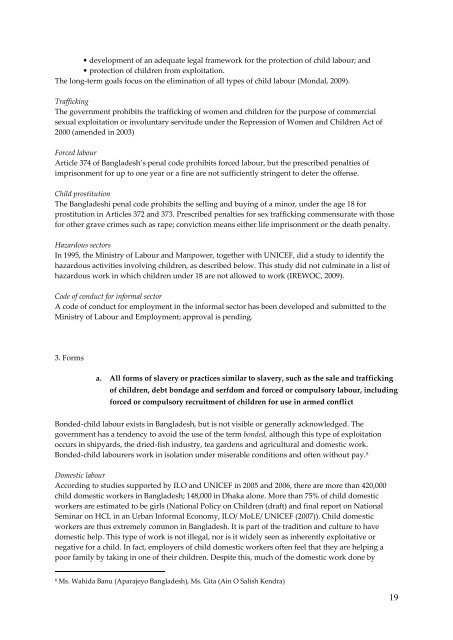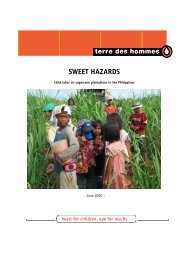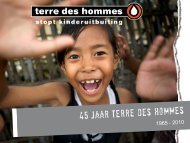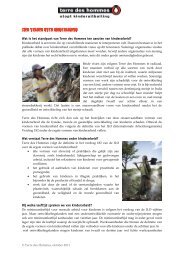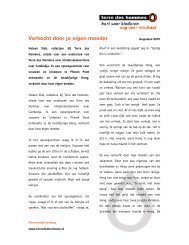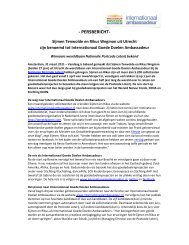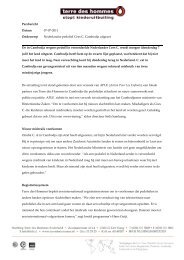Untitled - Terre des Hommes
Untitled - Terre des Hommes
Untitled - Terre des Hommes
- No tags were found...
You also want an ePaper? Increase the reach of your titles
YUMPU automatically turns print PDFs into web optimized ePapers that Google loves.
• development of an adequate legal framework for the protection of child labour; and<br />
• protection of children from exploitation.<br />
The long-term goals focus on the elimination of all types of child labour (Mondal, 2009).<br />
Trafficking<br />
The government prohibits the trafficking of women and children for the purpose of commercial<br />
sexual exploitation or involuntary servitude under the Repression of Women and Children Act of<br />
2000 (amended in 2003)<br />
Forced labour<br />
Article 374 of Bangla<strong>des</strong>h’s penal code prohibits forced labour, but the prescribed penalties of<br />
imprisonment for up to one year or a fine are not sufficiently stringent to deter the offense.<br />
Child prostitution<br />
The Bangla<strong>des</strong>hi penal code prohibits the selling and buying of a minor, under the age 18 for<br />
prostitution in Articles 372 and 373. Prescribed penalties for sex trafficking commensurate with those<br />
for other grave crimes such as rape; conviction means either life imprisonment or the death penalty.<br />
Hazardous sectors<br />
In 1995, the Ministry of Labour and Manpower, together with UNICEF, did a study to identify the<br />
hazardous activities involving children, as <strong>des</strong>cribed below. This study did not culminate in a list of<br />
hazardous work in which children under 18 are not allowed to work (IREWOC, 2009).<br />
Code of conduct for informal sector<br />
A code of conduct for employment in the informal sector has been developed and submitted to the<br />
Ministry of Labour and Employment; approval is pending.<br />
3. Forms<br />
a. All forms of slavery or practices similar to slavery, such as the sale and trafficking<br />
of children, debt bondage and serfdom and forced or compulsory labour, including<br />
forced or compulsory recruitment of children for use in armed conflict<br />
Bonded-child labour exists in Bangla<strong>des</strong>h, but is not visible or generally acknowledged. The<br />
government has a tendency to avoid the use of the term bonded, although this type of exploitation<br />
occurs in shipyards, the dried-fish industry, tea gardens and agricultural and domestic work.<br />
Bonded-child labourers work in isolation under miserable conditions and often without pay. 8<br />
Domestic labour<br />
According to studies supported by ILO and UNICEF in 2005 and 2006, there are more than 420,000<br />
child domestic workers in Bangla<strong>des</strong>h; 148,000 in Dhaka alone. More than 75% of child domestic<br />
workers are estimated to be girls (National Policy on Children (draft) and final report on National<br />
Seminar on HCL in an Urban Informal Economy, ILO/ MoLE/ UNICEF (2007)). Child domestic<br />
workers are thus extremely common in Bangla<strong>des</strong>h. It is part of the tradition and culture to have<br />
domestic help. This type of work is not illegal, nor is it widely seen as inherently exploitative or<br />
negative for a child. In fact, employers of child domestic workers often feel that they are helping a<br />
poor family by taking in one of their children. Despite this, much of the domestic work done by<br />
8<br />
Ms. Wahida Banu (Aparajeyo Bangla<strong>des</strong>h), Ms. Gita (Ain O Salish Kendra)<br />
19


